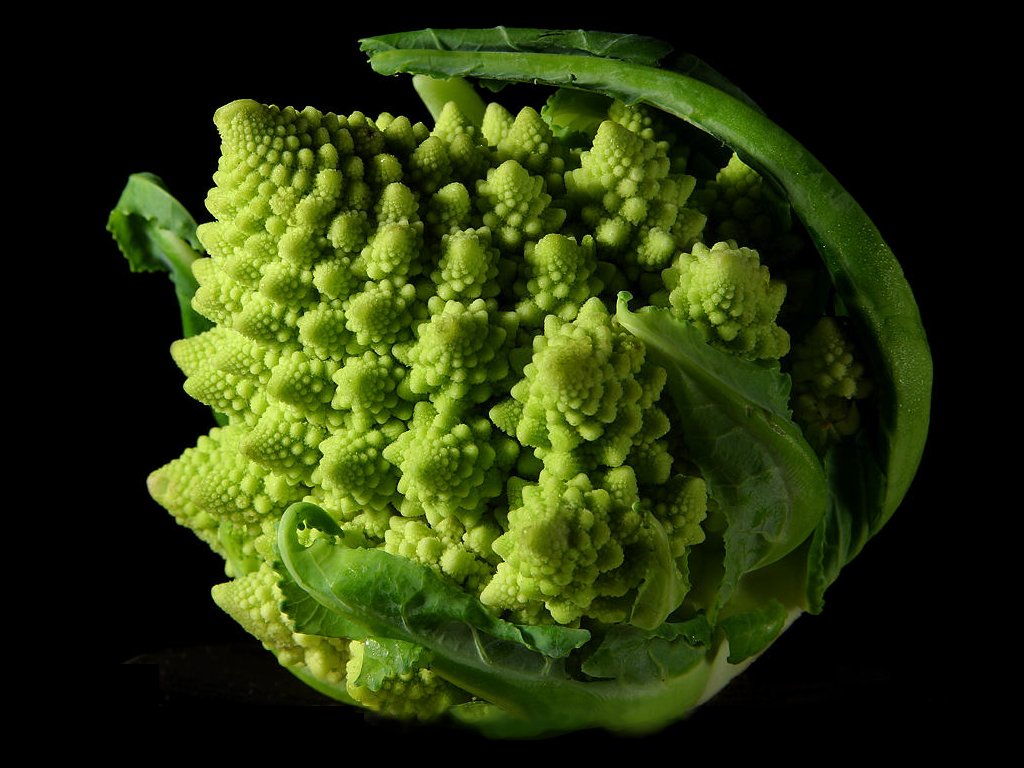The picture above is a vegetable called Romanesco broccoli. Yes, it’s real. It’s often referred to as fractal broccoli.
A fractal is a mathematical phenomenon involving a property called self similarity. It’s an object comprised of multiple components which can be split apart, but each of which resembles the whole.
There are variations on this theme, but here, and with quite a few other objects found in nature, it involves spirals. The spirals on the surface of Romanesco broccoli increase in size, but the shape of each component stays the same.
Viewed from far enough away, this piece of broccoli looks like a simple cone. Limited to this perspective, this is how one would describe it. And that would be technically correct.
If you look a little closer, it’s a cone made of spirals of other little cones. Again, if this is the closest you look, this description is correct.
Examine it in even more detail, and one sees that each of those little cones are actually composed of more tiny spirals of other cones which look identical to the largest version. This description, consisting of far more detail than the original perspective, is still accurate.
This pattern repeats for a remarkably long time. With the broccoli, at some point you’re just looking at single cells and the pattern stops, but in the case of fractals used in mathematics, the self-similar repetition can be theoretically infinite.
Apply this concept to understanding the complexity of the human body. No, I’m not saying that it’s self-identical in structure, although there are a surprising number of recurring ratios to be found. I’m referring to the repeating complexity to be found at each level of analysis.
When one first begins learning about human anatomy, physiology and kinesiology, it’s at the same level of perspective as when the broccoli just looks like a simple cone. It’s head, shoulders, knees and toes. Technically accurate, but limited.
Just as each cone on the piece of broccoli reveals further individual complexity upon closer examination, each component of the human body becomes more complex the closer you look at it.
For example, we all learned sometime in middle school that the knee is a hinge joint. Around the same time came the words femur, patella, tibia and fibula. Someone with this knowledge can fairly say that they understand what a knee is.
At this point, however, one must also consider that there are surgeons who have spent most of their lives specializing in this one particular joint. Like someone who looks at the broccoli under a microscope to see the countless layers of complexity invisible to the naked eye, these people possess a level of understanding far beyond what an average person “knows.”
You probably know what a kidney is, and could express the sum of that knowledge with about two sentences and a crude drawing of a bean. By most measures, you would not be wrong. But if you were to ask a nephrologist who spent a decade studying this organ, you’d realize how many layers of complexity exist beyond your grasp and how insufficient your knowledge is on a relative scale.
The same applies to every component of the body, and beyond that, how those components interact and function together.
Pick a random person off the street and ask them what a squat is. They’ll be able to tell you, and the information they’ll provide will be correct, but only because it’s at the most limited level of understanding. Ask Ron Hruska what a squat is, and the answer will be comparable to that of a knee surgeon in comparison to a sixth grader describing a hinge joint.
Knowledge is about more than correct and not correct. What the layman or your average weekend certification graduate describes correctly as a squat will probably be an abomination to Dave Tate. The metric of “correct” changes as understanding deepens.
To say that Romanesco broccoli is a green vegetable shaped like a cone is correct, but only if you fail to look closer. Each advancement in understanding reveals further layers of complexity.
When it comes to one’s knowledge about any particular subject, be aware that what you know, and what anyone else knows, is likely to be correct at some level.
The qualitative value of knowledge goes beyond right or wrong statements. It’s a matter of depth. Layers beneath layers of complexity. How deep does one’s knowledge run? How close have you looked? Do you know how much you don’t know? A statement can be “not wrong” and still lack enough understanding to matter.
An important component of knowledge is an awareness of how much one does not yet comprehend. The complexity of a living organism is quite possibly infinite, and if at any time we assume that we know everything there is to understand about something, it’s only because we’ve stopped looking closer.

